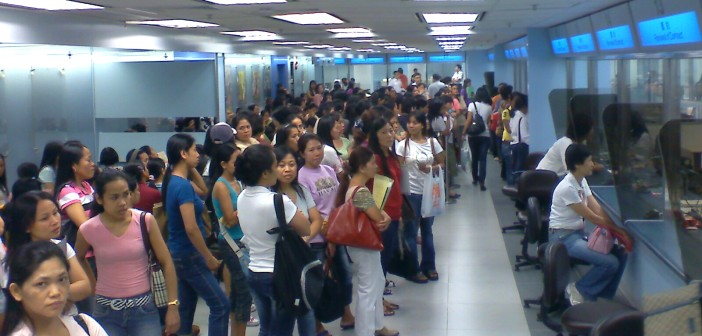Global alliance of overseas Filipino workers belied President Aquino’s claim in his last State of the Nation Address (SONA) that the number of OFWs (overseas Filipino workers) have been reduced due to supposed improved local job generation.
In its SUMA (Summing-Up of the State of Migrants Under Aquino 2010-2015), Migrante said under the Aquino administration, the number of OFWs leaving the country increased due to chronic joblessness and low wages – from 2,500 daily before Aquino assumed office in 2009, 4,018 in 2010, to 6,092 daily by early 2015 (per Department of Labor and Employment data).
Philippine Overseas Employment Administration (POEA) data likewise showed that the Aquino government has breached the two-million mark in OFW deployment processing in 2013, the highest record in the history of Philippine labor export.
Migrante International also said that the number of OFWs deployed far outpaced the jobs generated domestically.
According to a Philippine Statistics Authority (PSA) report, the number of locally employed Filipinos was only 1.02 million in 2014, or an average of 2,805 additional employed in the country daily.
Philippine Overseas Employment Administration (POEA) data likewise showed that the Aquino government has breached the two-million mark in OFW deployment processing in 2013, the highest record in the history of Philippine labor export.
The group said that while POEA data showed that there had indeed been a slight decrease in the OFW deployment, it was only in the fourth quarter of 2014. According to POEA data, 1.7 million OFWs were deployed during the last quarter of 2014, or 4,508 deployed daily. Deployment data nine months prior, however, pegged the number of OFWs leaving daily at 5,200.
In the past years, there had been a steady increase in the number of new hires and re-hires of land-based and sea-based OFWs.
POEA data clearly shows that the number of land-based workers deployed increased by 34.52%, or by 32.93% for new-hires and 35.26% for re-hires.
For seafarers, there was also an 11.11% increase in deployment from 2009 to 2013. Combined with the growing number of irregular OFWs who leave the country through the backdoor overall government figure of deployment does not support Aquino’s claim that migration has considerably lessened during his presidency.
In fact, OFW deployment has picked up considerably despite ongoing crises in host countries – to date, policies such as the Nitaqat or Saudization, stricter immigration policies and criminalization and deportation of millions of undocumented OFWs.
“If the government is attributing a so-called ‘reverse migration’ due to these factors, then it is right on spot. Since 2010, thousands upon thousands of OFWs in distress have been deported or forcibly repatriated back to the country due to civil unrests, calamities, economic instabilities and other similar factors in migrant-receiving countries,” said Sol Pillas, Migrante International secretary-general.
Pillas said that with the continuous repatriation of distressed OFWs from Saudi, Egypt, Syria and Libya, and the deportation of undocumented OFWs in Europe, Canada and the United States, then a “reverse migration” phenomenon could further be expected in the coming months.
“But to attribute a “reverse migration” due to so-called “inclusive growth” is outright deceitful and misleading.
With the record-high unemployment rate and the lack of a comprehensive and sustainable reintegration program for returning OFWs, a so-called “reverse migration” will not be tantamount to the Aquino’s claim that OFWs have been opting to come home for good. Filipinos will not be stopped from being forced to leave the country in search for “greener pastures” abroad. And so the cycle continues,” she said.
Migrante International maintained that the number of OFWs has increased significantly since Aquino took office. By 2012, at least one-fourth of the country’s labor force has gone abroad to find work.
According to DOLE, there are now 12 million OFWs abroad. Migrante International pegs the number of overseas Filipino workers between 12 to 15 million, to include undocumented OFWs.




